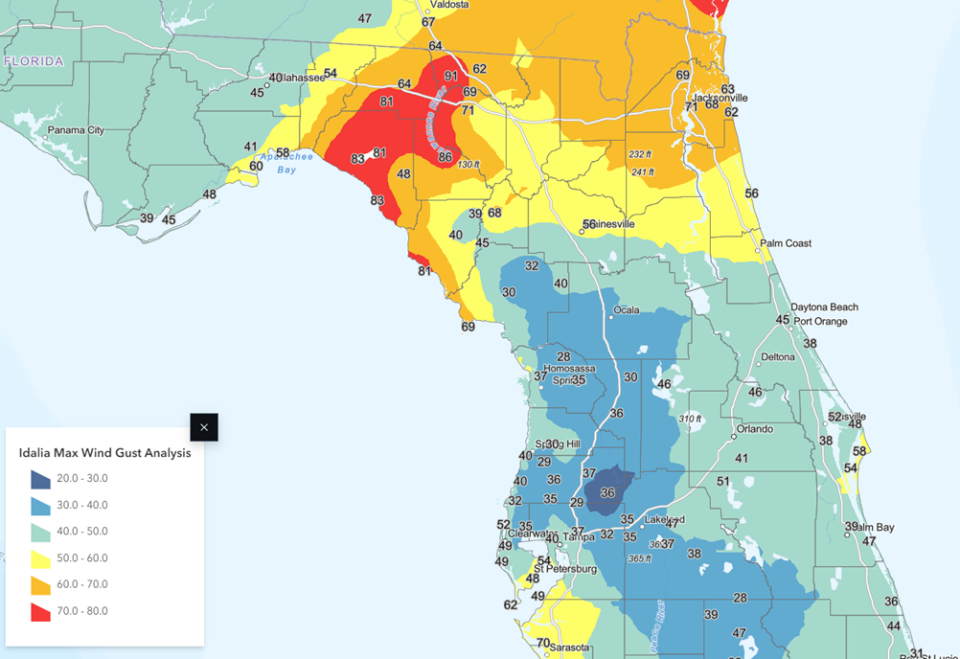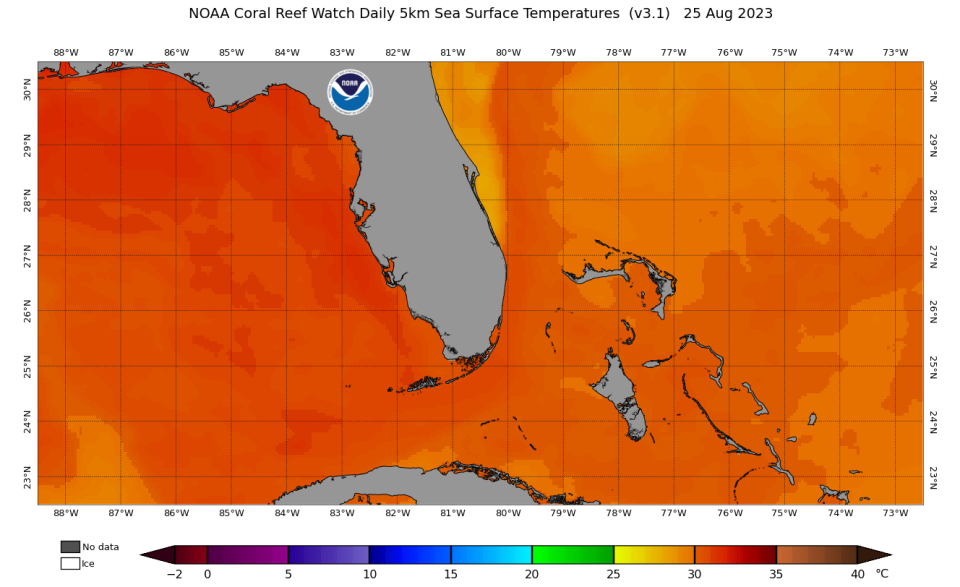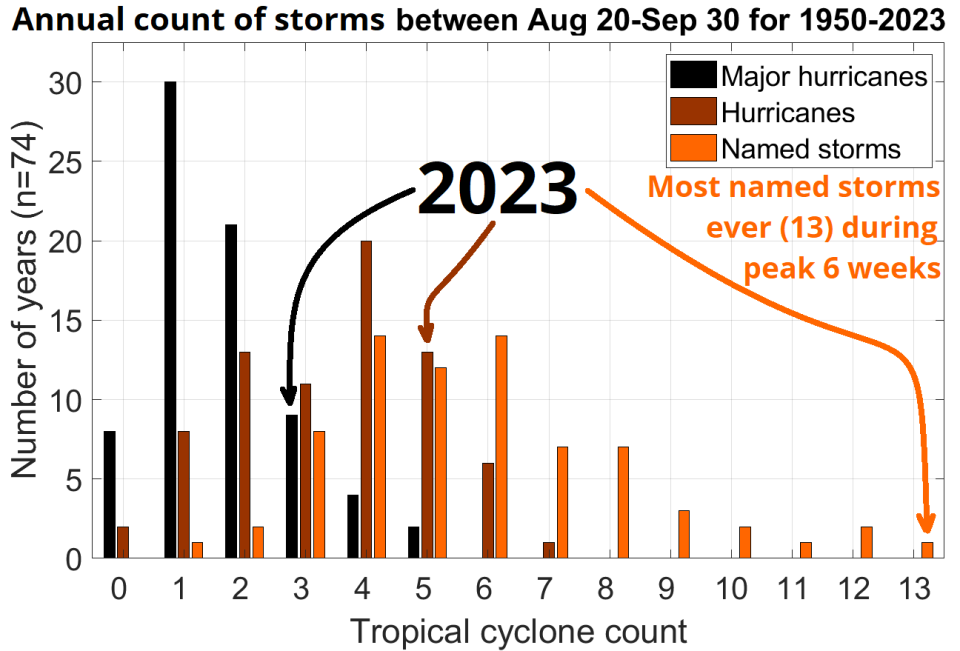Blow-by-blow account of hurricane season 2023: Did we start the Cat 4 fire? | WeatherTiger
Did we start the fire? The question has echoed down the halls of history since time immemorial, or at least since 1989, when Mr. William Joel denied all incendiary culpability. However, in the Year of Our Lord 2023, pervasive wildfires, historic heat, and blazing ocean temperatures across the globe called that contention into serious dispute.
In the Tropics, the 2023 Atlantic hurricane season burned through nearly the whole list of storm names and seared Florida’s Big Bend with an unprecedented major hurricane landfall. While the cumulative U.S. impact of 2023’s twenty storms — fourth-most on record — fell short of recent hyperactive hurricane seasons, it nonetheless massively overperformed expectations. The 2023 hurricane season may not have been a cocaine bear, but it was at least a caffeine bear, keeping forecasters’ heads on a swivel until the bitter end.
Befitting 2023’s chaotic zeitgeist (and to cleanse the palate from a disappointing updated version by Fall Out Boy), WeatherTiger’s season-in-review is hereby presented in loosely chronological, “We Didn’t Start the Fire” format. Who, in fact, started the fire? We report, you decide. Hit it, Pianoman!
January through July
Kev McCarthy, record warmth, unnamed subtropical storm, Reedy Creek, La Niña’s weak, Chinese spy balloon,
Bed Bath goes to the Great Beyond, Samuel Bankman-Fraud, Bud Light, alt-right, several more balloons,
David statue has no pants, so-called aliens, Netflix passwords, writers’ strike, LK-99,
Powerful El Niño forms, MDR has two June storms, Trainwreck in East Palestine, mayhem on the airlines,
Barbenheimer, Musk v. Zuck, mortgage rates going up, Taylor’s version, Mario, Wagner Group, dense smoke,
Orlando leper hotspot, Hunter Biden laptop, Orca whales sinking boats, zany submarine implodes,
Shear didn’t stop the season. No, the storms kept turning while the world was burning,
El Niño didn’t stop the season, They just kept on forming with Atlantic warming.

January storm sets tone for 'deeply weird year'
For the eighth time since 2015, the 2023 season got underway before its official start date, with a January subtropical storm reaching Nova Scotia setting the tone for a deeply weird year. As winter rolled into spring, the three-year reign of La Niña ended, and warming waters in the Central Pacific blossomed into a full-blown El Niño by early June.
Normally, El Niño increases the odds of an inactive Atlantic hurricane season by promoting strong wind shear over the Gulf and Caribbean. This time, however, WeatherTiger and other seasonal forecasters weren’t so sure, as key regions of the Atlantic were unusually toasty entering summer. Following Andrea’s inconsequential arc across the Gulf, Bret and Cindy developed between West Africa and the Antilles, the first time two tropical cyclones formed in the Atlantic’s Main Development Region in June.
These two systems were an ill portent that 2023 would not be a typical El Niño season. Though sea surface temperature anomalies rose further in the Atlantic and reached Jacuzzi-esque heights in the Florida Straits, July was quiet other than open-ocean Hurricane Don. Still, the year got off to a quick start, with over three times normal tropical activity through July 31st—but no U.S. landfalls. Yet.
August: 2023 Hurricane season's worst month
TikTok Cat 6, no one calls Twitter “X,” Hawaii fire,
Santos, friendship bracelets, Eras Tour,
Rich men north of Richmond, Rudy buys bail bonds,
Idalia is a Cat 4, I can’t take it anymore…
Hurricane Idalia: A 24-hour leap from Cat 1 to monster Cat 4
WeatherTiger’s August seasonal outlook update posited that a busy peak season lay ahead, but “development may focus on the eastern half of the Atlantic” and “storms would also have to negotiate a potential trough in the central Atlantic… before threatening the U.S. coast, which history shows is a tall order.” As 16 of the year’s 20 storms remained safely east of 72°W, this was a solid forecast.
With one exception.
Following a calm first two-thirds of August, four storms — Emily, Franklin, Gert, and Harold — developed within 48 hours of each other. Franklin became 2023’s first major hurricane; Harold winged southern Texas as a tropical storm. And as much of Florida smashed all-time monthly average temperature records, Idalia emerged from the Caribbean to convert 90°F Gulf waters into a furious major hurricane.
A 24-hour leap from Category 1 to Category 4 intensity on approach to North Florida made Idalia the first-ever major hurricane to make landfall in Apalachee Bay when it struck eastern Taylor County on the morning of August 30th.
Thanks to a last-minute eyewall replacement cycle, Idalia’s maximum sustained winds declined a bit before reaching land, but still caused extensive structural and agricultural destruction in the Big Bend and southern Georgia as it raced inland at 20 mph. Storm surge of 6-10’ overspread the Gulf Coast from Taylor County south to Cedar Key, and reached up to 4’ in Tampa Bay.
Thankfully, accurate and heeded warnings from the NHC prevented even a single death from occurring due to surge during Idalia, a plenty bad hurricane that narrowly escaped being much worse.

September through November
Lauren Boebert, Betelgeuse, probably a few more balloons, generative AI, Lee heads for the Maritimes,
Margot, Nigel, Philippe, October storms go out-to-sea, Menendez gold bar money, Xi Jinping: Blood and Honey,
Israel under attack, sixteen-dollar Big Mac, worthless debts, Talking Heads, Gaetz, Kev, Smash Mouth dead,
Purple streetlights, feral hogs, Milei has some cloned dogs, RFK mRNA, what else do I have to say?
Shear didn’t stop the season, no, the storms kept turning while the world was burning,
El Niño didn’t stop the season, they just kept on forming with Atlantic warming… on and on and on and on…
A quiet end to hurricane season 2023
Hurricane season kept rolling into fall, though deep, persistent troughing in the western Atlantic steered almost all activity away from the continental U.S. coast. The primary tropical intrigue in September was Lee, which attained Category 5 intensity prior to menacing New England as an immense Category 1, eventually swerving east of Maine as a potent post-tropical cyclone.
The only U.S. landfall was Ophelia, which nearly reached hurricane strength as it made a short-fused rush into eastern North Carolina. Elsewhere, Jose, Katia, Margot, Nigel, and Philippe elbowed each other for space in the eastern Atlantic and contributed to a record 13 named storm formations between August 20th and September 30th.
Two atypically late storms developed in the Main Development Region in October: harmless Sean and Category 1 Tammy, which brought flooding to the northern Lesser Antilles. Dry air kept a lid on Caribbean tropical threats in the late season, though South Florida took a hard hit from a non-tropical, frontal low juiced by Gulf warmth and moisture in mid-November.
One alarming takeaway from what became the most active season ever during a moderate or strong El Niño
Overall, 2023 was a year of zany sub engineering, and the consequences of zany sub engineering. ChatGPT passed and some political candidates failed the Turing Test. Fires raged, irrespective of cause. Oceans rose. Records fell. History failed to provide much context for what went down, weatherwise and otherwise.

The 145 units of Accumulated Cyclone Energy accrued by Atlantic storms in 2023 is more activity than about 75% of hurricane seasons since 1950, and about 50% above the long-term average of 100 ACE units. This is a remarkable outcome, given years with strong peak season El Niños average about 50 ACE units, making 2023 the most active season ever during a moderate or strong Niño.
Extreme ocean warmth across the Tropical Atlantic, which had never co-existed with El Niño prior to 2023, gave Atlantic storms extra thermodynamic zhuzh and kept wind shear at bay. However, El Niño likely exercised an influence on the steering patterns that kept most hurricanes away from land, with a few notable exceptions.
One alarming takeaway from 2023 is that El Niño can no longer be counted on to predictably reduce Atlantic hurricane risks. Hurricane scientists really didn’t know how a clash of a robust El Niño and anomalous Tropical Atlantic warmth would play out: now we’ve at least seen one outcome, and the result wasn’t all that reassuring.
Even so, El Niño events rarely last for two consecutive hurricane seasons. The five strongest fall El Niños since 1950 all dissipated in the following 6 to 12 months; 60% of subsequent years were above average or hyperactive hurricane seasons.

We’ll dig into the early 2024 prognosis more rigorously in December at weathertiger.com, though no one knows what next year will bring except the world’s foremost hurricane forecasting mastermind, George Santos.
Thanks for reading this season, and I hope WeatherTiger’s forecasts helped you make more informed and rational weather decisions in 2023. I’ll be back in the spring to help you begin navigating the psychological and meteorological minefield that surely lies ahead in 2024. In the meantime, try not to start additional conflagrations, and keep watching the skies.

Dr. Ryan Truchelut is chief meteorologist at WeatherTiger, a Tallahassee company providing forensic meteorology and expert witness services, and customized agricultural weather and hurricane consulting solutions. Get in touch at ryan@weathertiger.com or visit weathertiger.com to discover how to put our expertise to work for you.
This article originally appeared on Tallahassee Democrat: Hurricane season 2023 analysis: Most active ever in an El Niño year

